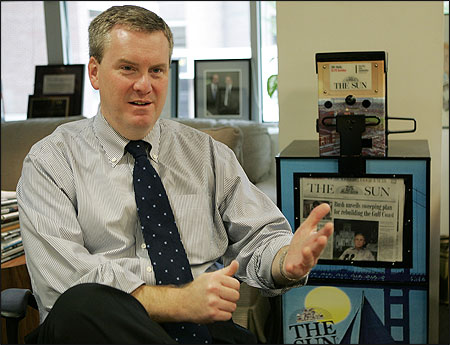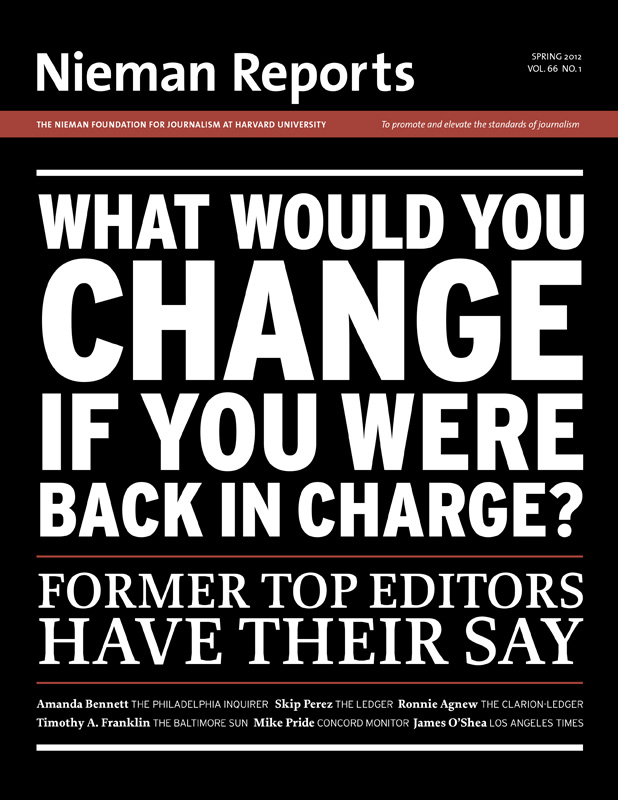
Former Baltimore Sun editor Timothy A. Franklin says his new mantra would be: “We are a digital news operation with a print component.” Photo by Chris Gardner/The Associated Press.
Hanging prominently in the lobby of The Baltimore Sun building is a black and white photo of the legendary H.L. Mencken. Along with his visage is this quote: "As I look back over a misspent life, I find myself more and more convinced that I had more fun doing news reporting than in any other enterprise. It is really the life of kings."
"Life of kings"? Nearly half a century after The Sun's icon uttered those words, there are few journalists at metro newspapers today who would echo that sentiment.
It doesn't have to be so.
The time for tinkering is past, however. Redesigns and the repackaging of print editions may temporarily stem declines. They will not save the franchise. Diluting the quality of journalism through quarterly budget cutting may ensure survival in the near term. It's a suicidal strategy over the long term.
It's been about three years since I occupied the editor's office, a glass-enclosed space at The Sun that included Mencken's old conference table, where he no doubt held court like a king. Since then, I taught journalism at Indiana University (IU) and now work as an editor at Bloomberg News.
Over that time, I've seen bright students voraciously consume news, most of it on their smart phones and laptops. And I've interacted with sophisticated Bloomberg readers who are willing to pay for quality news and data they receive on computer terminals and websites and via apps.
What do these IU students and Bloomberg subscribers have in common? They're smart, discerning readers who crave trusted, credible news and information.
And many don't rely on print daily.
No Prisoner to Pulp
If I were starting over in the top job at the Sun, knowing what I know now, my new mantra for the newsroom would be: We are a digital news operation with a print component. We are not a print newsroom with a digital component. That is the organizing principle that guides all of our decisions, I would tell my staff.
In Baltimore, it's time to break the daily ritual of printing newspapers and throwing them on driveways and stoops seven days a week. Yes, there's a risk in breaking readers' print habit. But that routine is in decline anyway. There are creative ways to maintain daily readership and build a bridge to the future.
My newsroom would acknowledge a painful reality. The print editions some days of the week—mainly Monday, Tuesday and Saturday—are so paltry they beg the question: Why am I paying for this? They're a physical manifestation of the decline of the business.
The considerable money spent on ink, paper, trucks, delivery agents, and news production those three days could be reinvested in improving the print editions on the other days. In the process, an entirely new delivery mechanism could be spawned.
Rather than manufacture and distribute print editions those three days, we would provide to our subscribers an e-reader such as a Kindle or a Nook. This serves the dual purpose of strengthening our print edition on key days, and building an e-reading habit for what will inevitably be an entirely digital future.
Your Local 'Siri'
My newsroom would aspire to be a service-oriented, one-stop news and information portal for the region. For a modest subscription fee, my newsroom would give readers different tiers of information based on the device they're using and their needs. Yes, frequent users would pay.
A breaking news desk would crank out headlines and two- or three-paragraph news accounts for smart phones and social media. This desk also would send news alerts via e-mail and Twitter.
At the same time, other editors, reporters, photographers and graphic artists would be creating in-depth and refined versions for print, tablet and website editions.
Our franchise Sunday newspaper will be meatier and a showcase for powerful local storytelling. We can afford it because we're cutting our print losses three other days of the week and using our resources differently.
More than being a source of news, however, we would be a go-to digital repository for community information and tips that readers need in their daily lives. Want to know the best place to catch a cab or what's the hot new restaurant? My newsroom would aspire to be the local equivalent of Siri, Apple's voice assistant, instantly providing answers to the questions you have about Baltimore. We'd create a Utilities Desk with editors who would create and update that information.
Personalities as Brands
Not everyone wants the entire content of the daily news report, any more than a music lover wants to buy an entire CD. We live in a world of niche interests. We would build brands within the brand.
In sports, for example, we would sell a monthly digital subscription that is less expensive than the entire paper, and give readers access to our beat writers for chats, video of news conferences, and all the stats they can handle.
We would aggregate stories and blogs from other credible sources that are relevant to fans of the Ravens, Orioles and the University of Maryland.
We'll also produce a weekly Baltimore sports magazine or tab that we'll sell separately.
Personalities can be brands, too. My newsroom would celebrate our personalities and create more of them. They provide a personal connection with readers and unique voices for the community.
Investigative Reporting
Perhaps the single biggest mistake editors and publishers have made in recent years is cutting the number of investigative reporters. Any new newsroom paradigm also must have a back-to-the-basics approach, with a commitment to accountability journalism. This is not a luxury. It's fundamental to the role of the news organization in the community. It builds trust with readers. It demonstrates that we have their best interests in mind.
Frankly, it's also good business. It puts the news organization at the center of the community conversation on issues that matter. It's also a point of differentiation at a time when our competitors' newsrooms have been pared by budget cuts.
My newsroom would cover the traditional city and suburban beats aggressively—city hall, statehouse, politics, cops, courts and schools. We would cover the major companies and industries. These beats are the lifeblood of what we do. My newsroom would have two full-time obituary writers.
It also would have a dedicated social media desk with editors connecting with readers on a personal level through sites like Facebook and Twitter and providing tailored news and information for those platforms. This is the best and most efficient way to engage with readers one-on-one and provide them with news and information they're interested in. To accomplish all this, my newsroom would not be bound by many of the conventions of legacy newspapers.
In an era of easy interactivity, my newsroom would have an opinion editor—not an entire editorial board—and there would be fewer institutional editorials. We would have op-ed columnists who engage with readers.
We would need fewer page designers and copy editors and more video editors and Web producers. We would need fewer general assignment writers and more reporters who are experts and can share that knowledge with readers via blogs.
It won't be a life of kings anytime soon. It could at least be a life of princes, however, if we boldly innovate and execute.
Timothy A. Franklin is a managing editor in the Washington bureau of Bloomberg News. He was the top editor of The Baltimore Sun, the Orlando Sentinel and The Indianapolis Star, and a senior editor at the Chicago Tribune. Before joining Bloomberg, he was the director of the National Sports Journalism Center and the Louis A. Weil, Jr. Chair at the Indiana University School of Journalism.



